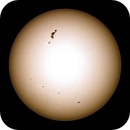Steven Fanutti:
I've never seen or captured a total solar eclipse, but I have many years of experience in solar photography. The common advice I read is that if you have never seen a total solar eclipse, enjoy the moment visually or else you will get all caught up in adjusting camera settings and totality will be over before you know it.
If you really want to capture the eclipse and are perhaps willing to compromise, you can capture the partial phases and just enjoy totality visually. For me, this is the plan (weather permitting), although I won't experience totality as I live in one of those 99% areas and I made the personal decision to avoid crowds and traffic during that day. For my most recent solar imaging project, I used a Sigma 150-500 mm lens with a 1.4x telextender for a total focal length of 700 mm. I used a Canon EOS T3 Rebel. I used Thousand Oaks Silver Black Polymer for the filter. For exposure, I used AV mode, ISO 200 and center-weighted average metering to get the right shutter speed. I then stacked 220 images and processed the result for the final image:

The Sun - March 5, 2024
You can photograph the partial phases the same way, but with a few differences. Here my tips apply to DSLR cameras:
- As more of the Sun gets covered, your camera will likely compensate by increasing the exposure time, overexposing the visible Sun. To avoid this, take a photo of the pre-eclipsed Sun, make note of the settings and dial the settings in Manual mode so that they remain the same during the partial phases of the eclipse.
- As the Moon is moving, if you are planning on stacking images, you won't be able to stack nearly as many as on a pre-eclipsed Sun. The Moon will be in a slightly different position relative to the Sun after each successive shot, even when shooting in a rapid sequence. However, you can still get greatly improved images by stacking as little as 10 photos. This keeps the visible motion of the Moon to a minimum in the stack.
- I recommend choosing a medium aperture value, such as f/10. In my experience, using a narrow aperture such as f/16, f/18, etc. revealed dust spots on the sensor, even after sensor cleaning. To minimize the chances of dust spots on the sensor showing on your images, do the Dust Delete Data procedure on your camera.
- There's a lot of buzz about the eclipse, but don't forget the Sun itself! This a solar maximum year, so a very large sunspot group may be visible. Even if you don't capture totality, seeing the Moon cover such a sunspot would make a nice photo to post on AstroBin!

A final point: Focal length really matters. Resolution goes up squarely proportional to the increase factor in focal length. For example, a lens with a 200 mm focal length will show the Sun in 4 times the resolution as a 100 mm lens will. A 700 mm focal length will show the Sun in 1.96 times the resolution a 500 mm lens will, which was the reason for my decision to purchase a 1.4x telextender. If you are planning to use a lens with less than a 200 mm focal length, you can still capture the partial phases and assemble a collage of the eclipse. A smaller solar disk will also affect the metering as there is more black in the image and you may have to do more trial and error with your camera settings.
Good luck! I hope this helps.
Thanks a lot Steven, this was very helpful. I’ll try not to get wrapped up in the photography but no promises. It looks like a sunny day today so I’ll try to practice a bit. I’m thinking just taking a few shots of the total eclipse with my dslr is what will let me take it all in visually and not be fussing with the ASIAIR settings.
|









